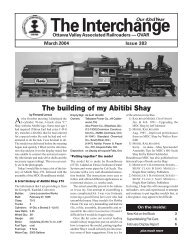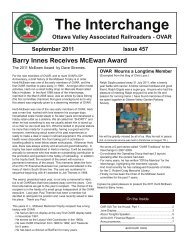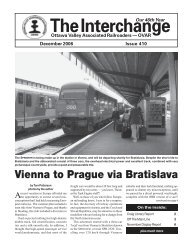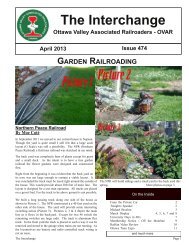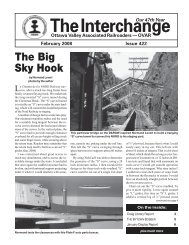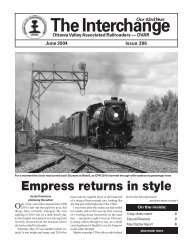June - Ottawa Valley Associated Railroaders
June - Ottawa Valley Associated Railroaders
June - Ottawa Valley Associated Railroaders
Create successful ePaper yourself
Turn your PDF publications into a flip-book with our unique Google optimized e-Paper software.
The Interchange<br />
<strong>Ottawa</strong> <strong>Valley</strong> <strong>Associated</strong> <strong>Railroaders</strong> OVAR<br />
<strong>June</strong> 2013 Issue 476<br />
MANAGING TRAFFIC ON OUR MODEL RAILROADS<br />
Car Cards Revisited<br />
Tom Patterson<br />
During the past 50 years or so, methods of<br />
managing traffic on our model railroads have<br />
evolved rapidly and with great diversity. Some,<br />
such as the Car Card and Bill of Lading system<br />
described by Doug Smith in the December<br />
1961 edition of Model Railroader, have stood<br />
the test of time and are still in use. Other<br />
methods have been developed which are<br />
variants of this insightful article. Currently,<br />
methods of organizing and directing our freight<br />
traffic vary from manually prepared switch lists<br />
to printed switch lists prepared through the use<br />
of sophisticated computer programs.<br />
All of these various methods have one<br />
essential objective in mind – to provide the train operator with<br />
the information required to properly switch cars in and out of a<br />
train consist. However, they vary in the following key<br />
characteristics:<br />
1. The degree to which they emulate prototype operations;<br />
2. The effort (and cost) to set up and maintain the system;<br />
3. The ease of learning and use by train operators;<br />
4. The facility of regulating the flow of traffic by the layout owner;<br />
5. Capacity in terms of trains, cars and varying traffic patterns;<br />
6. The accommodation of varying numbers of operators;<br />
and, first and foremost;<br />
7. The degree of enjoyment experienced by operators.<br />
My journey on this subject started with the tried and true Car<br />
Card and Bill of Lading method. It is easy to implement and<br />
directly emulates the prototype. And, this system has many<br />
practical advantages, such as ease of understand at the train<br />
operations level, once the layout topology is understood.<br />
However, I found the inherent and subtle difficulties in managing<br />
peaks and valleys in traffic demand too time consuming to<br />
resolve. I developed a similar but simpler system, which is the<br />
subject of this article.<br />
To provide background, I'll give a summary of my<br />
interpretation of the Car Card / Bill of Lading method, along with<br />
a description of the difficulties that I encountered. Next, I'll<br />
describe my “lite” version of this system, along with the pros and<br />
cons associated with it. Finally, We will follow a typical run on<br />
my layout to better illustrate this method.<br />
Train 471 departs its origin at Pacific. The first setout for Captain Concrete<br />
(NJ 311 and CN 529153) is marshalled directly behind Mikado 3540.<br />
Car Cards and Bills of Lading<br />
This traditional system is based upon a car card having a “foldup”<br />
pocket, which identifies the Road Code and Car Number of a<br />
railway car, along with other information which helps to match a<br />
Bill of Lading, and emulate the prototype (e.g., AAR Car Type,<br />
length, description, commodities). This card is typically inserted<br />
in a plastic sleeve.<br />
To route a car, a Bill of Lading is inserted in this sleeve, which<br />
typically contains 4 entries, each having:<br />
AAR Car Type code<br />
Commodity Description;<br />
Origin Location;<br />
Origin traders siding (spot);<br />
Destination Location; and<br />
Destination traders siding (spot).<br />
Continued on page 8<br />
On the Inside<br />
From the Private Car 2<br />
Tonight's Speaker 2<br />
Bolivia, Pantagonia and Paris 3<br />
Display 4, 5, 6, and 7<br />
Managing Traffic on our model railroads, cont'd 8<br />
Interchange Yard 11<br />
Refurbishing the Display Stand 11<br />
and much more<br />
The Interchange Page 1
FROM THE PRIVATE CAR<br />
<strong>June</strong> 2013<br />
I read recently that the big<br />
automobile companies are worried<br />
that young people are not bothering<br />
to learn how to drive. Today’s teens<br />
are thirty percent less likely to learn<br />
to drive. If you are trying to sell<br />
cars, a one third drop in new drivers might be quite disconcerting.<br />
When I grew up, learning to drive was a rite of passage. Having<br />
access to a car gave you greater freedom and more ability for<br />
social interaction. Today’s teens are thriving socially on their<br />
smart phones and are better connected than I ever was. There is a<br />
lot less need to access a car especially when there is greater<br />
access to public transportation.<br />
I was reading Classic Trains summer issue on Interurbans and<br />
thought that trolleys would have been the smart phone of the<br />
1920’s. That is, in urban areas, trolleys were the way you had the<br />
freedom as a teen to get around and interconnect socially. I<br />
remember when I was working in the hobby business years ago<br />
that I learned that interest in many crafts and hobbies was<br />
cyclical and would regain popularity after some period of hiatus.<br />
It would seem that trolleys and interurbans are in a bit of a<br />
revival as new light and heavy rail mass transit lines are being<br />
reintroduced to North American cities.<br />
The hobby of model railroading has changed significantly in<br />
recent years and has done a good job of keeping up with and<br />
taking advantage of the new technology of the day. So why when<br />
this feels like the good old days of model railroading that I sense<br />
a decline in the hobby? On a trip to Milwaukee I was appalled to<br />
learn that Model Railroader was not the highest circulating<br />
magazine at Kalmbach publishing. Would you believe that<br />
Astronomy had eclipsed my favorite railroad magazine?<br />
So what does this all mean? I’m not sure, but I hope it means<br />
that there are a lot of changes happening that will continue to<br />
improve the appeal of model railroading and that new people will<br />
discover and participate in the great hobby that we all enjoy.<br />
Railroading is not how I make my living; it is how I live.<br />
Robert Peck<br />
Whether it was taking the streetcar to and from school or,<br />
insisting to his dad that they must take one of the new PCCs to<br />
visit the ships at the waterfront, or bugging his mom every<br />
Sunday afternoon in the summer for a quarter so he could take a<br />
solo trip on the open observation streetcar around the mountain,<br />
Tom’s love for the street railway systems never dwindled in spite<br />
of abandonment of many systems throughout North America over<br />
the years.<br />
As an avid railfan, Tom has over the years had his photos<br />
published in all of the major North American railway magazines.<br />
He has also written a number of articles pertaining to streetcar<br />
systems and railway stations which appeared in Branchline and<br />
Canadian Rail. Tom has authored eight books on Streetcar and<br />
Interurban properties in Quebec. Two of his books, Montreal<br />
Streetcars Volume 2 and Volume 4 won the Canadian Railroad<br />
Historical Association, Book of the Year Award for 2006 and<br />
2011.<br />
Page 2<br />
Tonight's Speaker is Tom Grumley<br />
Tom Grumley was born and educated in Montreal. As the<br />
youngest son of a 44 year service employee of Canadian National<br />
Railways’ Dining Car Department, Tom became addicted to the<br />
“Train Bug” at an early age. Tom has fond memories of train trips<br />
to White River Jct. Vermont and <strong>Ottawa</strong> in the cabs of<br />
locomotives or in baggage cars while his dad worked as a Chef in<br />
the dining car. Tom’s mother forbade him from riding in steam<br />
locomotive cabs thanks to his older brother always coming home<br />
after a trip with dad completely black from head to toe! Tom had<br />
to settle for RS3s, FP9s and FPA4s. However, Tom’s real passion<br />
was first and foremost streetcars.<br />
Tom has been a member of OVAR since 1986 and has presented<br />
to the group on numerous occasions. He is also a member of the<br />
Bytown Railway Society (BRS), the CRHA and the C. Robert<br />
Craig Memorial Library.<br />
The Interchange
Answering the Call of Nature<br />
By Colin J. Churcher<br />
The other day I was watching a program on the railways of<br />
Bolivia showing shots of the vast, wide, completely flat altiplano<br />
with little or no vegetation. No bushes from horizon to horizon.<br />
I was in an inspection car on the altiplano. It was after a lunch at<br />
which we had consumed (nonalcoholic) liquid. Six people<br />
needing to answer the call of nature and not a bush in sight. We<br />
stopped the car but how to preserve our privacy? After some<br />
discussion, we stood round in a circle, facing outwards. This way<br />
we could relieve ourselves with an unimpeded view right to the<br />
horizon and a reasonable amount of privacy.<br />
Possibly the first tram on line T3b arriving at Porte de<br />
Vincennes<br />
Paris new streetcars<br />
Colin Churcher<br />
Another time I was on a railfan trip on the Old Patagonian<br />
Express narrow gauge line to Esquel in Argentina. It was the last<br />
runpast of the day and a member of the group desperately<br />
needed to answer the other call of nature. He stood with his feet<br />
on the 2 foot gauge rails, dropped his pants and proceeded to do<br />
his business. He was interrupted by a whistle as the train began<br />
to move off. Up came his pants in a hurry, he chased the train<br />
and managed to climb aboard the last car. Arriving at Esquel for<br />
the night the hapless traveler found he had lost his wallet which<br />
had probably dropped out of his pants at the last runpast.<br />
We retraced the same route the next day and the crew received<br />
a very strange train order. It was in Spanish but went something<br />
along the lines of:<br />
Watch out for a pile of human excrement between the rails near<br />
kilometre post xx. Stop and search for a wallet in this vicinity.<br />
They found the wallet.<br />
A new tramway line opened in Paris last December. The line<br />
runs mostly in the middle of wide streets with much use of grass<br />
between the rails and well laid stone at many of the stations. The<br />
line features some severe gradients. When I rode this tram on<br />
opening day, one wheel had a flat spot, possibly because of<br />
braking problems on the severe grades. One station is built on a<br />
hill and passengers are warned about this.<br />
A tram ready to depart Porte de la Chapelles for Porte de<br />
Vincennes. The line of buses on the right provides good<br />
connections<br />
The Interchange Page 3
May Display Non Canadian<br />
The display was a great collection of sleek, colourful, exotic trains, or familiar North American rolling stock. We had great<br />
structures as well. Photos by Larry Lanctot.<br />
Burnell Cox, Southern Pacific "Golden State" GS4 484<br />
HO Locomotive by Broadway Limited. Used on Coast Daylight<br />
between Los Angeles and San Francisco<br />
Mike Hind, TGV Thalys, N scale model by Kato.<br />
Prototype built by Alstrom, first ran in 1996,<br />
Paris Bruxelle Köln Amsterdam.<br />
Bob Smith, OO scale (?) Irish Rail "A" class diesel, built in<br />
1956 by Metropolitan Vickers EMD, 1325 HP double end cab.<br />
rebuilt in 1968, still 20 in service in 1989.<br />
Model by Lima<br />
Lloyd Stresman, HO, Riverossi, VIRM (Vellengd InterRegio<br />
Materiel) of the Nederland Spoor (Netherlands Railways).<br />
VIRM was initially developed in the 90s by Bombardier and<br />
NS for intercity service. It is an increased capacity double<br />
deck EMU using energy saving three phase propulsion.<br />
Mike Hind, N, model by Bachmann British Railway 45596,<br />
Jubilee Class "Bahamas" If anyone can tell Mike how to<br />
remove the top of the tender, he will be most grateful.<br />
David Taylor, OO scale, Class 66 model by Bachmann<br />
Built by GMD London ON. David bought the model on a trip<br />
to London UK. Model has DCC and sound by Loksound<br />
Grant Bruner, N scale, Caledonian Railway 4P Class Tender<br />
Locomotive and BR Dutchess Class "Queen Elizabeth"<br />
Pacific. 1980's Grahamfarish Nscale models<br />
Robert Peck, HO, CNR D5 260 purchased at <strong>Ottawa</strong> Train<br />
Expo. The engine will be rebuilt and painted for CNR on<br />
Vancouver Island. Rob reports the engine needs TLC, but<br />
has a can motor and the correct oil tender. She will get a<br />
western pilot and sound.<br />
Page 4<br />
The Interchange
May Display Non Canadian<br />
Continued from page 4.<br />
Grant Knowles, HOn3,<br />
scratchbuilt Colorado & Southern<br />
RB1.<br />
Based on the HallScott railbus<br />
design, scratchbuilt of styrene,<br />
brass and misc castings.<br />
Utilises NWSL gear boxes.<br />
The rail car has a detailed interior,<br />
working lights and"runs like a<br />
charm"<br />
Paul Anderson, O tinplate,<br />
Louis Marx, 1950.<br />
Engine was packed away in 1980<br />
and rediscovered while cleaning<br />
out a relative house. It is said to<br />
be the last tinplate train made<br />
before Marx went to plastic.<br />
Eric Smith, HO models by Jouef<br />
of France.<br />
"L'ORIENT EXPRESS" <br />
Paris Istanbul with<br />
connections to Cairo, Baghdad<br />
and Tehran; all first class<br />
sleepers, undoubtedly the world's<br />
most romantic train,<br />
or "LE TRAIN BLEU" <br />
Calais Paris Nice, of the<br />
WagonLits company.<br />
The train ran war and politics<br />
permitting, before and after World<br />
War II.<br />
All sleeping cars, the actual train<br />
carried a few more cars.<br />
The locomotive is an ex Paris<br />
LyonMéditerranée (PLM) Pacific,<br />
rebuilt by André Chapelon of the<br />
SNCF.<br />
More Display photos on page 6<br />
The Interchange Page 5
May Display Non Canadian<br />
Continued from page 5.<br />
(Card missing) An impressive train set of lithographed<br />
cars. Most of the details are printed on the cars, for a<br />
rather effective presentation of colourful prototypes<br />
Chris Lyon, HO, Fleishmann. 1962 vintage locomotive and<br />
rolling stock. The company started using plastics for the<br />
first time along with their zinc alloy frames.<br />
Andrew Chisholm, HO, "Could have been" prototype. This<br />
boxcar celebrates the 101st anniversary of when the<br />
construction started on what has become known as "The<br />
Titanic Railroad". The line was to connect Central Vermont<br />
at Palmer with Port of Providence, RI. When GT president<br />
Hayes went down with the Titanic, so did the funding.<br />
Page 6<br />
Bill Crago, HO, Car by C&BT Shops, collector series. B &<br />
O 467010 is a 1944 40ft AAR boxcar in LCL "Timesaver"<br />
paint scheme.<br />
The Interchange
Bill Crago, HO, Gramp's Gas & Buddy's Auto Body<br />
The building is scratch built, mostly from<br />
wood, to Bill's own design, incorporating a<br />
couple of ideas from commercial kits. The<br />
variety of materials reflect changes over<br />
time. Board and batten for the original 1914<br />
structure, tonge and grove for the first<br />
addition, clapboard for the second and steel<br />
for the final bay. It was finished using a<br />
combination of stains and paint to reflect the<br />
nature of the construction. Lighting is 3 volt<br />
LED with a battery pack in the leftmost bay.<br />
Gramps sells enough gas to pay the bills.<br />
Grandson buddy is the "best body man in<br />
these here parts"<br />
Greg Stubbings, HO, HH Goode Company<br />
Feed Mill<br />
R. Pezze, HO, 1958 Road Scene<br />
Streetcar scene with a wrecking crew coming to<br />
tear down the old building<br />
This Bar Mills Majestic Feed and Hardware Kit features laser cut walls and a myriad of details, overhead pipes, different<br />
additions and towers. Greg still had to install the roof flashing and weather the tin on the roof and tower. The signs<br />
come from a photo of the mill in Uxbridge, Ontario. The model captures the look of this small town feed mill and will<br />
serve as a long term standin.<br />
The Interchange Page 7
Car Cards Revisited cont'd<br />
The four Bill of Lading entries are arranged so that only one<br />
shows when inserted in the Car Card.<br />
For my implementation, I used unique card stock colours for<br />
eight different car type groupings (e.g., blue for box shaped<br />
(house) cars, tan for tank cars, green for gondola or open top cars,<br />
etc.), for both Car Cards and Bills of Lading. I also colour coded<br />
all locations, and added a coloured dot adjacent to each<br />
destination location, except offline locations.<br />
Examples of these cards are illustrated below. The centre item<br />
is a standard car card inserted in a plastic sleeve. To the left is an<br />
example of the traditional “4 element” Bill of Lading, 2 elements<br />
of which are shown. To the right is my highly simplified use of<br />
the car card principle to direct traffic. Note – on my layout,<br />
reefers and insulted boxcars share a common purpose<br />
In very simplistic terms, the combined Car Card and Bill of<br />
Lading (Waybill) directed yard masters and train crews as they<br />
built trains and spotted cars. Once spotted, the Bill of Lading was<br />
advanced to the next of the four entries. Once again, train crews<br />
and yard masters would use the next Bill of Lading data to<br />
determine switching tasks and fulfill train service design plans.<br />
Setting up this scheme is no more onerous than others – a<br />
facility with computer tools helps in the creation of stickon tabs<br />
containing car and bill data. The colourcoding applied to<br />
Iroquois Falls (Red) is illustrated on the sample Bill of Lading.<br />
No switch lists result. Operations do require a space to sort out<br />
cards, which is a requirement that switch list systems do not<br />
have.<br />
Nevertheless, the major issue that I encountered with this<br />
system was the adjustment of Bills of Lading in use so as to<br />
smooth out traffic peaks and valleys, and thereby provide a<br />
reasonably consistent amount of traffic “fodder” for the train<br />
service plan. Many times, I had to pick and choose Bill of Lading<br />
cards to generate a satisfactory traffic mix. Or, I had to create<br />
more Bills of Lading to suit my layouts’ traffic patterns. I<br />
understand that this problem arises with some computerbased<br />
systems as well. So, what to do??<br />
Card System “Lite”<br />
applying destinations for 50 cars would probably last for about<br />
three 2 hour operating sessions.<br />
Why?? Because, for most of my operating sessions, not all<br />
planned trains run. My layout features a lot of switching, and<br />
trading of traffic blocks. I really did not require a lot of cars with<br />
defined destinations, only enough for a 2 to 3 hour operating<br />
session.<br />
I also realized that modelling traffic to and from “off layout”<br />
locations (e.g., Eastern Canada, USA) could not easily be<br />
accommodated within my modest real estate.<br />
So, instead of a “perpetual motion” traffic scheme incorporated<br />
in the Car Card and the 4 Bill of Lading system, I opted to a<br />
“melt down”, but “regenerative” scheme. I used the same Car<br />
Cards as before, but simply substituted one destination for the 4<br />
Bills of Lading entries. Once the car arrived at the destination<br />
spot, this “one destination” card would be removed from the car<br />
card by the crew and returned to the “destination cards” rack for<br />
reassignment. Eventually, all Card Cars would be devoid of<br />
“destination cards”. Before this happened, of course, yard<br />
masters would be building trains by stuffing new “destination<br />
cards” in empty Car Cards to fulfill train consist requirements.<br />
Not an onerous task compared to finding the right destination on<br />
the right Bill of Lading card for the right train.<br />
Road Switcher 471<br />
Confusing?? Yes, of course it is. So, let’s follow the<br />
marshalling and running of a road switcher under this “lite”<br />
scheme to further illustrate this method. Road switcher 471 runs<br />
Westbound out of Pacific. (Pacific was originally conceptualized<br />
as a staging area, but it quickly “morphed” into a respectable<br />
terminal!). Train 471 operations feature the setting out a traffic<br />
block for spotting by another assignment (e.g., industrial switcher<br />
or local “turn”) as well as the direct exchange of traffic from<br />
within its consist and particular spots.<br />
First question how do we build 471’s consist and assign<br />
“destination cards”?? Well, each of my train specification cards<br />
has a matrix which relates cars which could be handled, to the<br />
available spots, as illustrated below:<br />
Well, I stepped back and realized that a full operating plan on<br />
my modest layout includes 2 road switchers, 2 mixed trains and 2 On the obverse is a sort of service design specification, which<br />
“turns”, as well as 2 yard assignments and 2 industrial switching defines the train’s marshalling, route, work requirements, etc.<br />
jobs. An average of 5 cars per train/assignment meant that about (The diligent reader will discover that this “service design” card<br />
50 cars would require destination definition for one operating still contains instructions designed for the “4 element” Bill of<br />
“run”. My layout car capacity is around 100 freight cars, and Lading method!) (See next page)<br />
Page 8<br />
The Interchange
ultimately removed by the assigned industry crew when they<br />
have completed spotting the cars.<br />
Train 471 arriving Captain Concrete<br />
Train 471 approaches Captain Concrete. The two cars to be picked (DM 6101<br />
and CN 331025) up are on the setout/pickup (service) track. A similar<br />
operation occurs at Iroquois Falls, in which Train 471 switches a setout/<br />
pickup track, but does not directly spot or pull cars.<br />
Using these two items, a yard master may select cars which<br />
match the train’s requirements, then stuff the destination card into<br />
the car card. A very flexible rule of thumb is used for train length<br />
– 5 cars, more or less. Once the yard master has switched the<br />
cars into a departure track in properly blocking order, the train<br />
crew may append a van and depart. No dispatching is required –<br />
my whole layout runs on a simple version of “joint work<br />
authority”, (UCOR Rule 266, modified by CN Time Table<br />
Special Instructions, if you’re really into this rules stuff!), which<br />
is devoid of dispatchers and paper. It is vaguely similar to the<br />
“smoke” meets fabled to have existed on the Canadian Prairies<br />
during the steam days.<br />
Further on the subject of flexible rules, it is generally expected<br />
that the train crew will switch cars “oneforone” on a per spot<br />
basis. However, this will not always be possible. So, the even<br />
more general rule is “you can pick up whatever cars you want,<br />
within reason”.<br />
Today’s 471 has a consist as follows:<br />
Spotting setout, showing car cards<br />
Our train has completed its work at Captain Concrete, and is set<br />
to depart. The waybills for the two cars setout still contain their<br />
bills of lading. They will be removed by the industry crew, which<br />
is currently running the 44 Tonner.<br />
The operation of train 471 at Ste. Rosalie is different, but<br />
similar to that at Fraser Mills, in that 471 directly spots and pulls<br />
cars. In these instances, traffic cards are removed and returned to<br />
the “destination card rack” at the end of the train run.<br />
Train 471 departs its origin at Pacific. The first setout for<br />
Captain Concrete (NJ 311 and CN 529153) is marshalled directly<br />
behind Mikado 3540.<br />
So, train 471’s first work location is Captain Concrete, a line<br />
point location at which this train is required to set out and/or lift<br />
traffic, but not pull or spot individual cars – the detailed Train 471 observes a slow order on the wood trestle crossing<br />
switching will be done by an assigned industry crew at the plant. Marsh La Mousse. They will switch CB&Q 183914.<br />
So, the traffic cards are left in the car sleeves for setouts, and<br />
Continued on page 10<br />
The Interchange Page 9
Crossing Marsh La Mousse, the next piece of work for 471 is<br />
clear sight. The empty covered hopper (CN 113020) in 471’s<br />
consist must be switched directly by the 471 crew for CB&Q<br />
183914 at Ste. Rosalie in the back ground.<br />
The last photo illustrates the retention of destination cards for<br />
setouts until they are finally placed on spot.<br />
Added Confusion<br />
You may have noticed that the service design for train 471<br />
allows for the setout of Iroquois Falls traffic “overflow” at Glen<br />
Sanford. How come?? Well, the Pacific yardmaster may well<br />
discover that his yard is plugged, and that he has to sluff off some<br />
of the cars. Why not send them to Iroquois Falls by way of Glen<br />
Sanford, which is a second yard on my layout? So, train 471 may<br />
have too many cars for the three car back track at Iroquois Falls.<br />
Solution?? Set the excess cars out at Glen Sanford for the Turn<br />
that services Iroquois Falls.<br />
Just to make the point, CN 113020 is shown on spot with the<br />
destination card and car card dissociated.<br />
Then next stop on 471’s route is Iroquois Falls. Like the<br />
operation at Captain Concrete, 471 does not spot or pull specific<br />
sidings. Rather, this train lifts traffic from a service track, and<br />
replaces it with traffic destined to specific spots within Iroquois<br />
Falls.<br />
Train 471 departs Iroquois Falls en route to Glen Sanford<br />
Further, if Glen Sanford is plugged, then 471 could be<br />
persuaded to pick up excess cars and return them to Pacific.<br />
Switching Iroquois Falls<br />
Arriving at Iroquois Falls, the crew notices that two cars on the<br />
service track are to be lifted by 471.<br />
The service track at Iroquois Falls contains two cars which have<br />
been placed there by another assignment, the Iroquois Turn from<br />
Glen Sanford. The next Turn will spot cars set out by today’s<br />
edition of 471.<br />
Running through Glen Sanford<br />
Our 471 crew is happy today as it runs through Glen Sanford.<br />
No extra work to do!<br />
For other assignment within my operating plan, substantial local<br />
switching is required. Up to 7 spots must be switched. It this<br />
case, manual fiddling with cards is not efficient, so card sorting<br />
racks have been established where required.<br />
Page 10<br />
Train 471 runs past the Bulkley <strong>Valley</strong> Paper Mill<br />
The Interchange
Moving on to its next work location, train 471 runs past the<br />
Bulkley <strong>Valley</strong> Paper Mill near Fraser Mills. Bulkley <strong>Valley</strong> has<br />
a card sorting rack and also the track diagram which helps<br />
operators determine the exact spot for their traffic.<br />
Conclusion<br />
All to say, this method of traffic management is highly flexible<br />
and open to the imagination of the operating crews. As we gain<br />
experience, I expect that the collaboration between layout<br />
operators will open up a new vista of operating enjoyment.<br />
Interchange Yard<br />
HO SCALE MODULES FOR SALE<br />
It’s been 10 years since I built my first set of modules. There are<br />
many other aspects of modular railroading that I wish to<br />
explore. Not having a large enough home, van or enough time, I<br />
have decided to liquidate certain assets in my collection. I have<br />
received many compliments on the fine craftsmanship over the<br />
years. Lots of photos of the models have been taken as they<br />
have appealed to many model railroading fans. The following<br />
modules can be yours to enjoy! Sale is by email auction.<br />
Modules to be sold:<br />
1. FALLOWFIELD and VESTA (4 module set)<br />
2. COLONNADE (2 module set)<br />
3. HEAVY METALS, BONEYARD and MUSKRAT<br />
RIVER (set of 3 modules).<br />
Please contact Gilbert Lacroix for full details on placing a bid<br />
and complete descriptions of the lots. Email:<br />
g.lacroix701@rogers.com .<br />
Auction closes July 22, 2013 at 12 noon.<br />
For Sale<br />
Railfan/Railroad Magazines<br />
Vol.1 No.1 (Winter 1974) to date (Nov. 2012), 375 magazines<br />
all in mint condition, Aug. 1999 issue missing/misplaced<br />
Make a reasonable offer. Thomas.grumley@sympatico.ca.<br />
Wanted.<br />
Two <strong>June</strong>co K27 Canadian Pacific 45' Express Reefer Car kits.<br />
Contact John Moore at 6135842128.<br />
FROM THE<br />
EDITOR'S DESK<br />
We had 15 contributors this season, many with<br />
more than one article. Thank you every one. I am looking<br />
forward to every articles you send me. I don't count members of<br />
the executive as contributors when the write about OVAR<br />
business, but thank you as well gentlemen for your material.<br />
We had three contributors to "Off the Mainline" That would be<br />
a good starting point for a short article, actually, all you need is<br />
an email with a few lines about the happenings on your railway.<br />
It need not be serious or complex. If you have a new siding and<br />
a new customer, send us a "press release" and add a photo taken<br />
with your cell phone.<br />
Can you refurbish the Display Stand<br />
Our Display stand has served faithfully for many<br />
years already, and shows wear and tear. It is<br />
also rather heavy when setting up and tearing<br />
down.<br />
The OVAR executive is searching for someone<br />
who can take the project of refurbishing the<br />
Display Stand. One concept is to divide the<br />
Display in two separate cases, and add space in<br />
each to store the lights that must be set up with<br />
the stand. Having the two halves as separate<br />
stands would let us set a display for rolling stock<br />
bracketting one or two tables to display structures<br />
and artefacts.<br />
OVAR will of course come to a compensation<br />
agreement with the person or persons who would<br />
take this project.<br />
If you are interested by this project, talk to Rob<br />
Peck or Peter Jackson.<br />
Railfanning CP Westminster Sub<br />
August 8th at Mile 6.76 on the CP Westminster Sub at<br />
Cumberland. CP 59056011 (Both GMD SD402’s), lead a<br />
moderate length train over the Cumberland Crossing and<br />
pass the Crossover Switch at Mile 7 on the CP sub and Mile<br />
Summer is here, I wish every one a safe and pleasant summer<br />
and enough time to get around to progress on your projects.<br />
144 on the CN sub. Of course Skytrain can be seen racing<br />
Don't forget to tell us the story!<br />
past on the overhead guideway. Andy Cassidy<br />
Normand Levert<br />
The Interchange Page 11
Coming in September<br />
After Dinner Presentation<br />
Chris Lyon<br />
Every Day is Train Day:<br />
Convention Railfanning<br />
in the Eastern United States<br />
The Display<br />
YOUR SUMMER PROJECTS<br />
The Display is anything you wish to bring and show to OVAR<br />
members. Works in progress are welcome, as are readytoroll out<br />
of the box, as are new or old modelling efforts. Each month has a<br />
suggested theme. The suggested theme is to inspire you to bring<br />
something.<br />
completelty different.<br />
Everything is welcome, whether it is in the theme or<br />
It can be models, structures, photos or<br />
artefacts. If it interests you, it will interest most OVAR members.<br />
St.Anthony Soccer Club Hall<br />
523 St. Anthony Street,<br />
<strong>Ottawa</strong><br />
(just off Preston Street at the Queensway)<br />
Doors open at 5:30 p.m.<br />
Dinner served at 6:30 p.m.<br />
Admission: $25.00<br />
Includes dinner, facilities, program, expense, taxes and<br />
gratuities.<br />
Parking<br />
Free parking available at St. Anthony SC or across Preston<br />
Street at the Adult High School, near the school.<br />
Please note.<br />
If you cannot attend the dinner after saying you would,<br />
please call Fred Mills, the Dinner Chair, at 6137231911.<br />
Thank you.<br />
Page 12<br />
Chair: Robert Peck 6132694193<br />
Vice Chair: Peter Jackson 8197782737<br />
Secretary: Mike Shore 6138298867<br />
Treasurer: David Copeland 6138255027<br />
Membership: John Howard 6137223155<br />
Program: Andy Chisholm 613 2580089<br />
Dinner: Fred Mills 6137231911<br />
Archives: Dave Knowles 6137224473<br />
Webmaster: Steve Watson 6135923609<br />
Video Library: Bill Scobie 819 6846212<br />
Interchange: Normand Levert 6138677904<br />
Web Site: www.ovar.ca<br />
The Interchange<br />
<strong>June</strong> 2013 – Issue 476<br />
Staff<br />
Features, story ideas, comments.<br />
Email to the Editor: ovar.interchange@gmail.com<br />
Distribution and mailing.<br />
Mike Shore<br />
25 Bainbridge Ave<br />
<strong>Ottawa</strong> ON K2G 3T1<br />
6138298867<br />
Submission of articles.<br />
The Interchange welcomes your submissions that<br />
may be of interest to club members. Material can<br />
be submitted to the Editor via email, memory stick,<br />
CD, DVD, typewritten, or even handwritten.<br />
Copy Deadline.<br />
September Issue, August 24th.<br />
Printing and copying.<br />
Impression Printing, Smiths Falls.<br />
OVAR<br />
Directory<br />
20122013<br />
May Dinner Attendance<br />
119<br />
Next OVAR Meeting:<br />
Tuesday, Sept 10, 2013.<br />
The Interchange is published ten times a year,<br />
September through <strong>June</strong>, by the <strong>Ottawa</strong> <strong>Valley</strong><br />
<strong>Associated</strong> <strong>Railroaders</strong>. Opinions expressed are<br />
those of the Editors or individual authors, and are<br />
not necessarily those of OVAR.<br />
©2013.<br />
The Interchange



